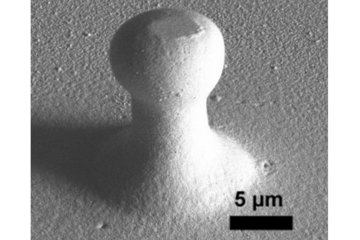All genres
221.
Journal Article
Bonding behavior and chemical stability of silica-based nanotubes and their 3D assembly. Journal of Physical Chemistry C 118 (16), pp. 8416 - 8423 (2014)
222.
Journal Article
Influence of the size and shape of silica nanoparticles on the properties and degradation of a PBI-based high temperature polymer electrolyte membrane. Journal of Membrane Science 454, pp. 12 - 19 (2014)
223.
Journal Article
Ion polished Cr/Sc attosecond multilayer mirrors for high water window reflectivity. Optics Express 22 (22), pp. 26526 - 26536 (2014)
224.
Journal Article
A 3D insight on the catalytic nanostructuration of few-layer graphene. Nature Communications 5, 4109 (2014)
225.
Journal Article
Study of nanometer-scaled lamellar microstructure in a Ti–45Al–7.5Nb alloy – Experiments and modeling. Intermetallics 18 (4), pp. 509 - 517 (2010)
226.
Journal Article
Interface structure of epitaxial (111) VN films on (111) MgO substrates. Thin Solid Films 517 (3), pp. 1177 - 1181 (2008)
227.
Journal Article
Nanometer-scaled lamellar microstructures in Ti–45Al–7.5Nb–(0; 0.5)C alloys and their influence on hardness. Intermetallics 16 (7), pp. 868 - 875 (2008)
228.
Journal Article
N–K electron energy-loss near-edge structures for TiN/VN layers: an ab initio and experimental study. Analytical and Bioanalytical Chemistry 390 (6), pp. 1447 - 1453 (2008)
229.
Journal Article
Combined ab-initio and N–K, Ti-L2,3, V-L2,3 electron energy-loss near edge structure studies for TiN and VN films. Zeitschrift für Metallkunde/Materials Research and Advanced Techniques 98 (11), pp. 1060 - 1065 (2007)
230.
Journal Article
Mechanical size-effects in miniaturized and bulk materials. Advanced Engineering Materials 8 (11), pp. 1033 - 1045 (2006)
231.
Journal Article
Bonding at copper-alumina interfaces established by different surface treatments: a critical review. Journal of Materials Science 41 (16), pp. 5161 - 5168 (2006)
232.
Journal Article
TEM investigation of the structural evolution in a pearlitic steel deformed by high pressure torsion. Metallurgical and Materials Transactions a-Physical Metallurgy and Materials Science 37 (6), pp. 1963 - 1968 (2006)
233.
Journal Article
Characterization of biocompatible Ti(CNO) layers on polymeric substrates. Applied Surface Science 219 (3-4), pp. 329 - 337 (2003)
234.
Journal Article
Equilibrium amorphous silicon-calcium-oxygen films at interfaces in copper-alumina composites prepared by melt infiltration. Journal of the American Ceramic Society 84 (3), pp. 623 - 630 (2001)
235.
Journal Article
Onset of microstructural instability in a fully lamellar Ti-46.5 at.% Al-4 al.% (Cr,Nb,Ta,B) alloy during short-term creep. Zeitschrift für Metallkunde/Materials Research and Advanced Techniques 91 (9), pp. 755 - 760 (2000)
236.
Journal Article
Microstructure of alumina composites containing niobium and niobium aluminides. Journal of the American Ceramic Society 83 (2), pp. 397 - 402 (2000)
237.
Journal Article
Microstructure of Iron Substrates Borided with Ni2B Particles by Laser-Induced Surface-Alloying. Zeitschrift für Metallkunde 90 (11), pp. 920 - 929 (1999)
238.
Journal Article
Microstructure and Tribological Properties of Ni-Based Claddings on Cu Substrates. WEAR 225-229 (1), pp. 18 - 26 (1999)
239.
Journal Article
Electron-energy-loss spectroscopy studies of Cu-α-Al2O3 interfaces grown by molecular beam epitaxy. Philosophical Magazine A: Physics of Condensed Matter, Structure, Defects and Mechanical Properties 78 (2), pp. 439 - 465 (1998)
240.
Journal Article
Growth and Structure of Internal Cu/Al2O3 and Cu/Ti/Al2O3 Interfaces. Acta Materialia 46 (3), pp. 759 - 772 (1998)











